DHQ Dihydroquercetin
Specification: 98% Dihydroquercetin
Test Method: HPLC
CAS Registry No: 480-18-2
Appearance: Light Yellow to white powder
Functions:Antioxidant
MOQ: 1KG;
Certifications: GMP,ISO9001:2015,ISO22000:2018,HACCP,KOSHER and HALAL
Sample: Free sample available
Production Capacity: 50KG/month
Delivery Time: Delivery within one day from the warehouse
Shelf Life: Two years
Payment: Multiple terms acceptable like T/T, LC, DA
Company Advantage:100,000 level clean production workshop, Non-additive, Non-GMO, Non-Irradiated/treat by heat only.
- Fast Delievery
- Quality Assurance
- 24/7 Customer Service
Product Introduction
What is DHQ Dihydroquercetin?
Dihydroquercetin(DHQ), also known as Taxifolin(TAX), is a natural flavonoid compound derived from the roots of the Douglas fir (Diospyros koraiensis). It is hailed as the "King of Vitamin P," possessing antioxidant capabilities far exceeding those of mainstream antioxidants. It effectively scavenges free radicals and slows down aging. Furthermore, it exhibits significant effects in protecting the cardiovascular system, reducing inflammation, regulating blood lipids, and enhancing immunity.

Healthkintai® specializes in the research and production of yew extract (dihydroquercetin) and possesses extensive industry experience. We sincerely invite you to wholesale our high-quality 98% dihydroquercetin products. Please feel free to contact us at health@kintaibio.com.
COA of KINTAI DHQ Dihydroquercetin
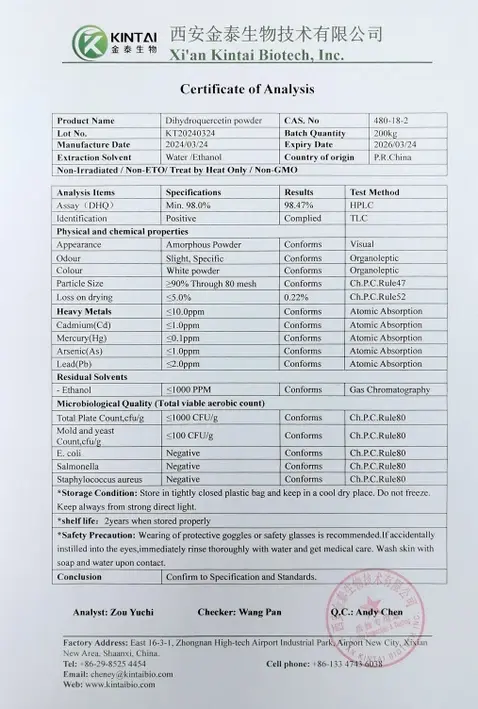
Chemical & Physical Properties
|
Property |
Description |
|
Chemical Name |
(2R,3R)-2-(3,4-dihydroxyphenyl)-3,5,7-trihydroxy-2,3-dihydrochromen-4-one |
|
Synonyms |
Taxifolin, DHQ |
|
CAS Number |
480-18-2 |
|
Molecular Formula |
C₁₅H₁₂O₇ |
|
Molecular Weight |
304.25 g/mol |
|
Appearance |
White to off-white fine crystalline powder |
|
Melting Point |
~ 240 °C (dec.) |
|
Solubility |
Soluble in: Methanol, Ethanol, DMSO, Ethyl Acetate. Sparingly soluble in: Water. Insoluble in: Non-polar solvents (e.g., Hexane, Chloroform). |
|
Storage |
Store in a cool, dry, and dark place. Keep container tightly sealed under an inert atmosphere. |

Sample available! Contact us now>>>
Dihydroquercetin vs Quercetin
While both dihydroquercetin (also known as taxifolin) and quercetin are potent flavonoid antioxidants found in plants, they exhibit distinct chemical structures and biological profiles that influence their applications.
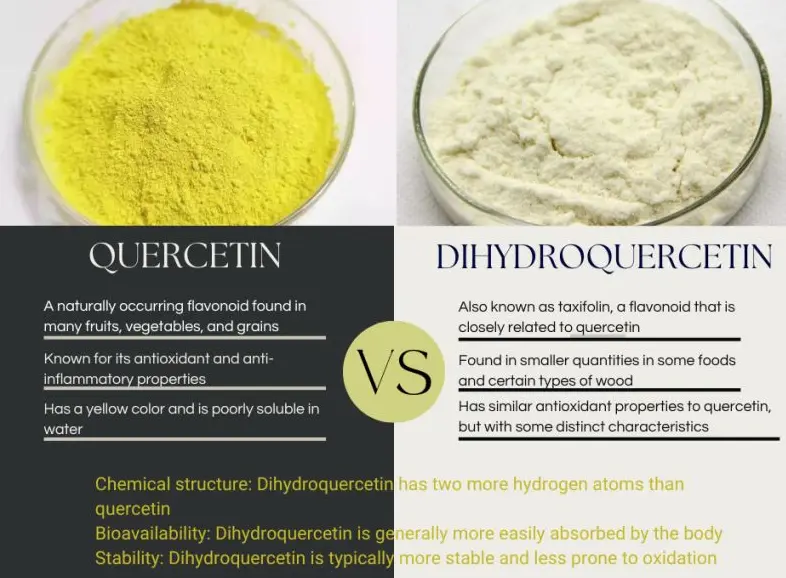
The fundamental difference lies in their molecular structure: DHQ dihydroquercetin is the hydrogenated form of quercetin, meaning its core structure is fully saturated. This subtle change grants dihydroquercetin superior stability and a remarkably high purity as a fine crystalline powder. More importantly, this saturation is believed to contribute to its enhanced safety profile and different metabolic pathway, potentially leading to better bioavailability and fewer interactions with enzymes like cytochrome P450, which is crucial for drug metabolism. In contrast, quercetin, with its unsaturated double bond, is one of the most widely studied flavonoids and is abundant in many foods. However, its bioavailability can be limited without specific formulations.
In terms of function, both are powerful free-radical scavengers, but dihydroquercetin is often noted for its exceptionally strong, direct antioxidant action and is frequently chosen for premium nutraceutical and cosmetic formulations where purity, stability, and a high safety margin are paramount.
Dihydroquercetin for liver
Epidemiological studies have shown that high protein and high cholesterol intake are associated with an increased risk of liver fibrosis and hepatitis, and have been shown to induce severe steatosis, inflammation, and fibrosis. Alcohol consumption and high-fat diets are major contributing factors to fatty liver disease; regardless of whether one has non-alcoholic fatty liver disease (NAFLD), long-term alcohol abuse can lead to alcoholic liver disease. According to Chang et al., excessive alcohol consumption on a high-fat diet can induce acute liver injury, highlighting the risk of alcohol abuse in obese/overweight individuals.

TAX can improve and reverse fat accumulation caused by a high-fat diet combined with excessive alcohol consumption, exhibiting a certain protective effect on the liver. It shows potential in the treatment of both alcoholic and NAFLD, but its exact mechanism requires further investigation.
(Reference:Dihydroquercetin inhibits mouse hepatic steatosisinduced by high fat diet feeding plus acute ethanolbinge,WU Mei,QIAO Chun-ying,YE Huan,WU Yan-ling,NAN Ji-xing,LIAN Li-hua( College of Pharmacy, Yanbian University, Yanji Jilin133002,China)
DHQ dihydroquercetin benefits
1. Antioxidant and Anti-aging
Taxifolin is a recognized top-tier natural antioxidant, with antioxidant capabilities far exceeding those of Vitamin C and Vitamin E. It effectively neutralizes and eliminates free radicals in the body, reducing oxidative stress damage to cells, thereby protecting cell structure and helping to delay the aging process of the body and skin from its root.
2. Cardiovascular Health Maintenance
It effectively lowers the level of low-density lipoprotein ("bad" cholesterol) and raises the level of high-density lipoprotein ("good" cholesterol) in the blood, thus regulating blood lipids. Simultaneously, it strengthens capillary resilience, improves microcirculation, helps stabilize blood pressure, prevents atherosclerosis, and comprehensively supports cardiovascular health.
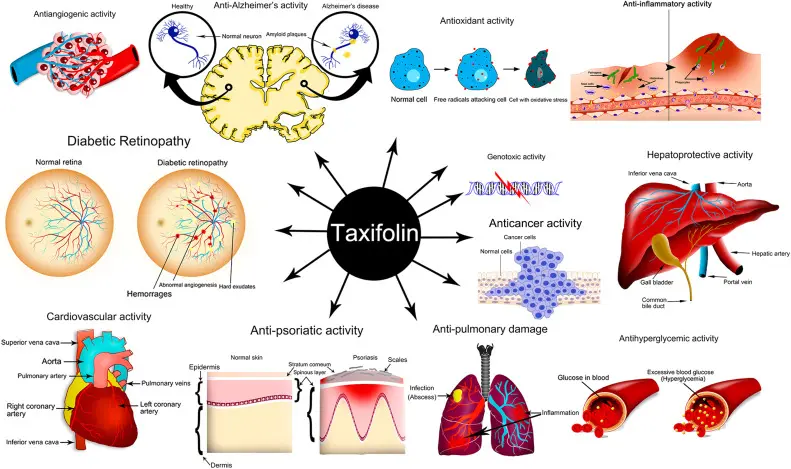
3. Anti-inflammatory and Anti-allergic
Taxifolin can inhibit the excessive release of inflammatory mediators such as histamine, effectively reducing inflammatory responses. It has a significant relieving effect on inflammatory allergic diseases such as allergic rhinitis and asthma, and is a natural anti-inflammatory component.
4. Enhanced Immunity and Liver Protection
It enhances the body's immunity by optimizing immune cell function. Simultaneously, it effectively reduces the damage of toxic substances to the liver, promotes liver cell regeneration and repair, helps repair chemically induced liver damage, and has a significant protective effect on the liver.
5. Promotes Skin Health and Beauty
Its powerful antioxidant capacity protects skin collagen from free radical damage and inhibits the degradation of elastic fibers, thereby helping to maintain skin elasticity and reduce wrinkle formation. Furthermore, it can inhibit tyrosinase activity, helping to reduce pigmentation and achieve a brightening effect on skin tone.
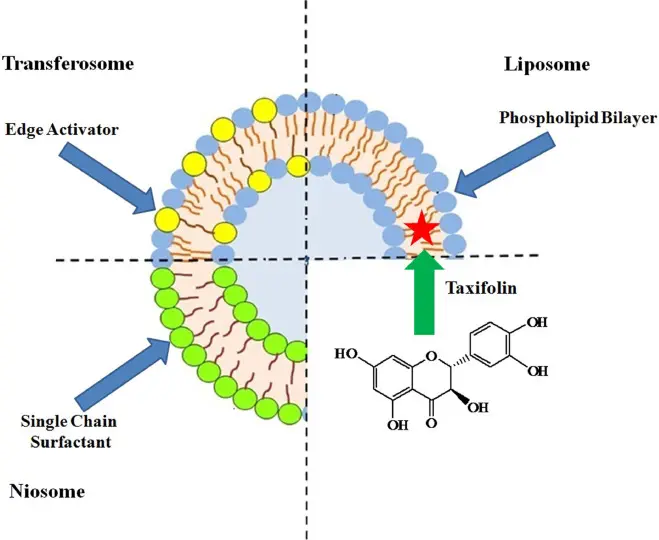
Dihydroquercetin Uses
1. Pharmaceuticals and Health Products
The core application of dihydroquercetin lies in its outstanding bioactivity and therapeutic potential. It has been extensively developed as a cardiovascular protectant, liver protectant, and anti-inflammatory and anti-allergic drug. With its ability to regulate blood lipids, enhance vascular elasticity, and improve microcirculation, it plays an important role in the prevention and adjunctive treatment of atherosclerosis and hypertension. Simultaneously, its powerful antioxidant and anti-inflammatory properties can effectively repair chemically induced liver damage and alleviate symptoms of allergic rhinitis and arthritis, providing a natural adjunctive treatment and health maintenance option for patients with chronic diseases.
2. Functional Foods and Beverages
As a highly effective and natural functional factor, DHQ dihydroquercetin greatly enhances the health value of products. It has been innovatively added to sports nutrition products, health supplements, and high-end functional beverages. For athletes, it can quickly eliminate the large number of free radicals generated by high-intensity exercise, effectively reducing muscle oxidative damage and fatigue, thereby accelerating physical recovery. In terms of daily health maintenance, it provides ordinary consumers with a convenient daily source of antioxidants, while its natural properties align with the current consumer trend towards clean labels.

3. Cosmetics and Personal Care
TAX, with its superior antioxidant and cell repair capabilities, has become a core ingredient in high-end anti-aging products. It is widely used in serums, creams, and sunscreens, directly protecting skin collagen and elastin fibers from damage by neutralizing free radicals generated by UV rays and environmental pollution, thus significantly delaying wrinkle formation and improving skin firmness. Furthermore, it effectively inhibits tyrosinase activity, playing a key role in brightening skin tone and evening skin texture in whitening and spot-fading products, achieving multi-dimensional skincare.

4. Animal Nutrition and Food Industry, and Other Fields
Dihydroquercetin also shows broad application prospects. In livestock farming, as a green feed additive, it helps improve animal immunity and stress resistance, and may improve meat quality. In the food industry, its powerful antioxidant properties give it great potential as a natural preservative, which can be used to delay the rancidity of easily oxidized foods such as edible oils and meat products, helping to extend their shelf life and meeting the growing market demand for natural preservatives.

Why Choose KINTAI DHQ?
- Superior Quality: We employ high-purity processes, resulting in extremely low impurity content and a purity of up to 98%. This ensures that the product's bioactivity and stability far exceed industry standards, providing customers with safe and efficient raw material guarantees.
- International Certification: Our production base strictly adheres to international quality management systems and has obtained authoritative certifications such as ISO and HACCP. Our quality meets international standards and is accepted in the global market.
- Flexible Customization: We can provide professional, personalized customization services in terms of purity, particle size, and packaging to precisely match your product application solutions, based on your specific needs.
FAQ
Q1:What is the use of dihydroquercetin?
A1:Dihydroquercetin, a potent natural flavonoid primarily sourced from the Douglas fir tree, is renowned for its exceptional antioxidant capacity. Its primary use revolves around neutralizing harmful free radicals in the body, thereby protecting cells from oxidative damage. This fundamental action translates into several key health applications: it supports cardiovascular health by improving blood vessel elasticity and aiding lipid metabolism, promotes liver detoxification and repair, and exhibits significant anti-inflammatory effects, which can benefit conditions like allergies and arthritis. Furthermore, its ability to combat oxidative stress makes it a valuable ingredient in anti-aging skincare and dietary supplements for overall wellness and enhanced immunity.
Q2:Is dihydroquercetin the same as quercetin?
A2:No, dihydroquercetin and quercetin are distinct compounds, though they are closely related flavonoids. The key difference is structural: DHQ dihydroquercetin (also known as taxifolin) has a saturated C-ring, while quercetin has an unsaturated double bond in its core structure. This seemingly small change significantly impacts their properties. Dihydroquercetin is often noted for its superior stability, higher purity as a crystalline powder, and a potentially more favorable safety and bioavailability profile with fewer drug-interaction concerns. Quercetin, more widely studied and abundant in foods, sometimes faces challenges with bioavailability. While both are powerful antioxidants, dihydroquercetin is frequently chosen for premium formulations where exceptional purity and a strong safety margin are paramount.
Our Certifications
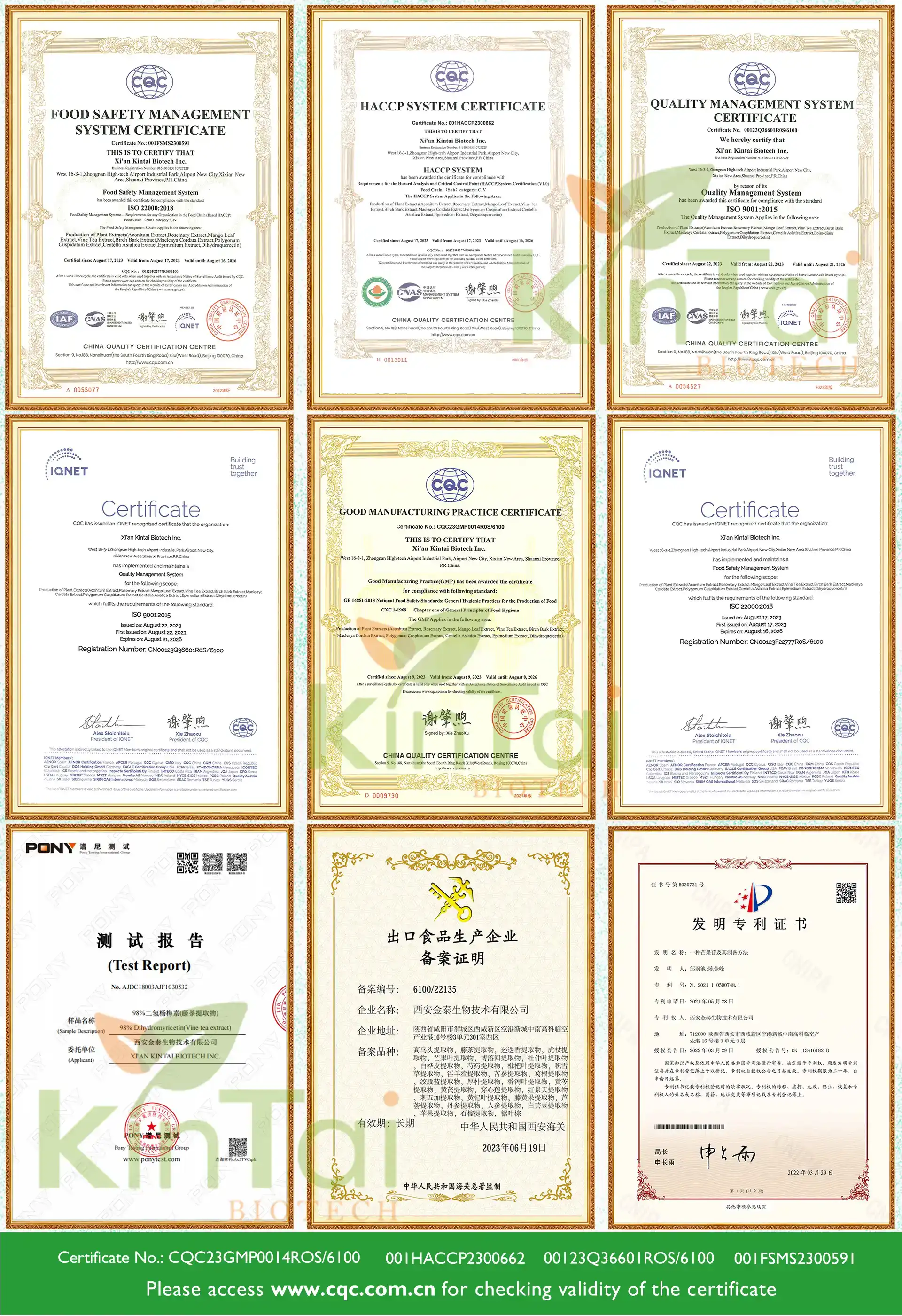
Send Inquiry
You May Like
0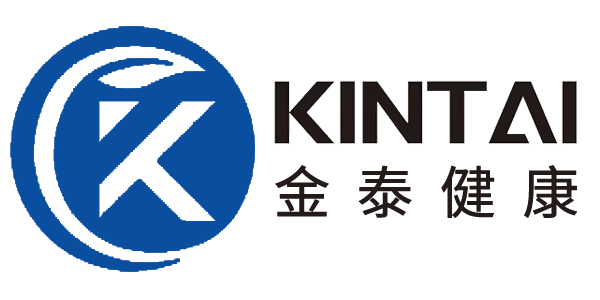
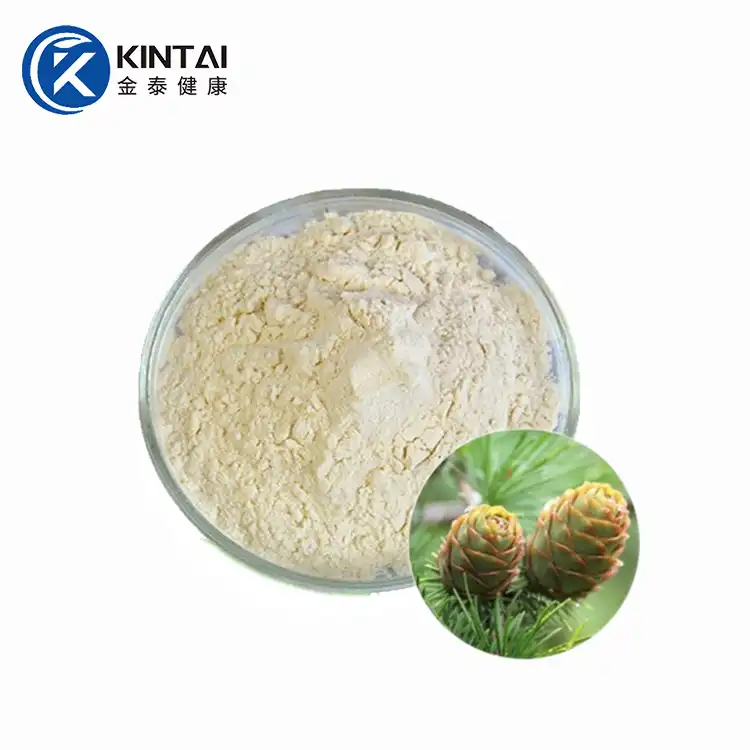
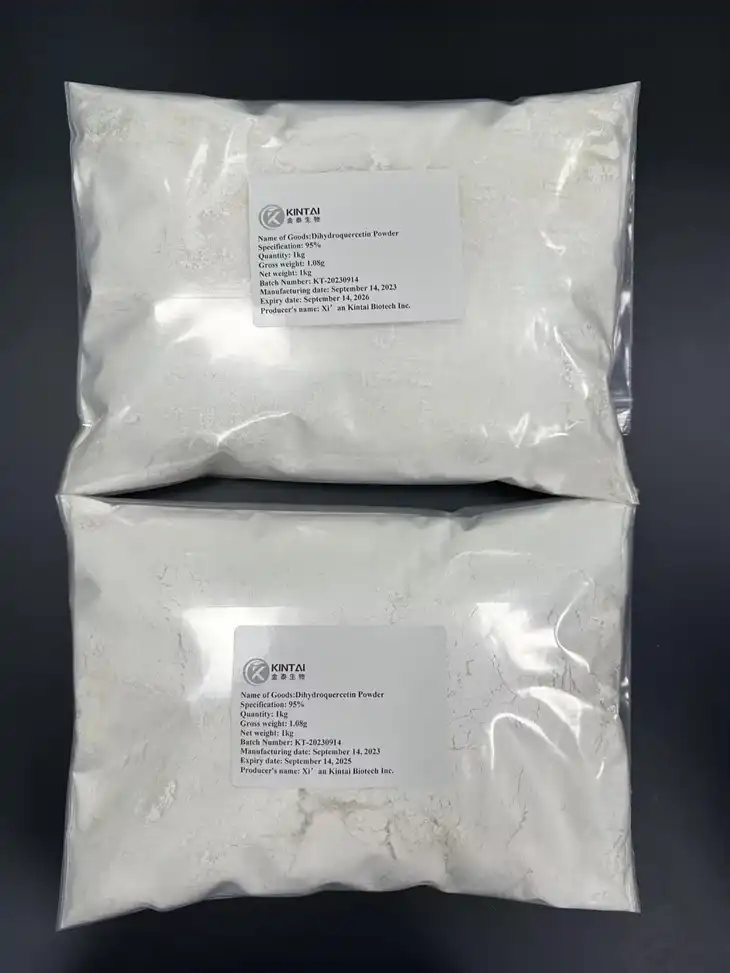
_1762999830573.webp)
